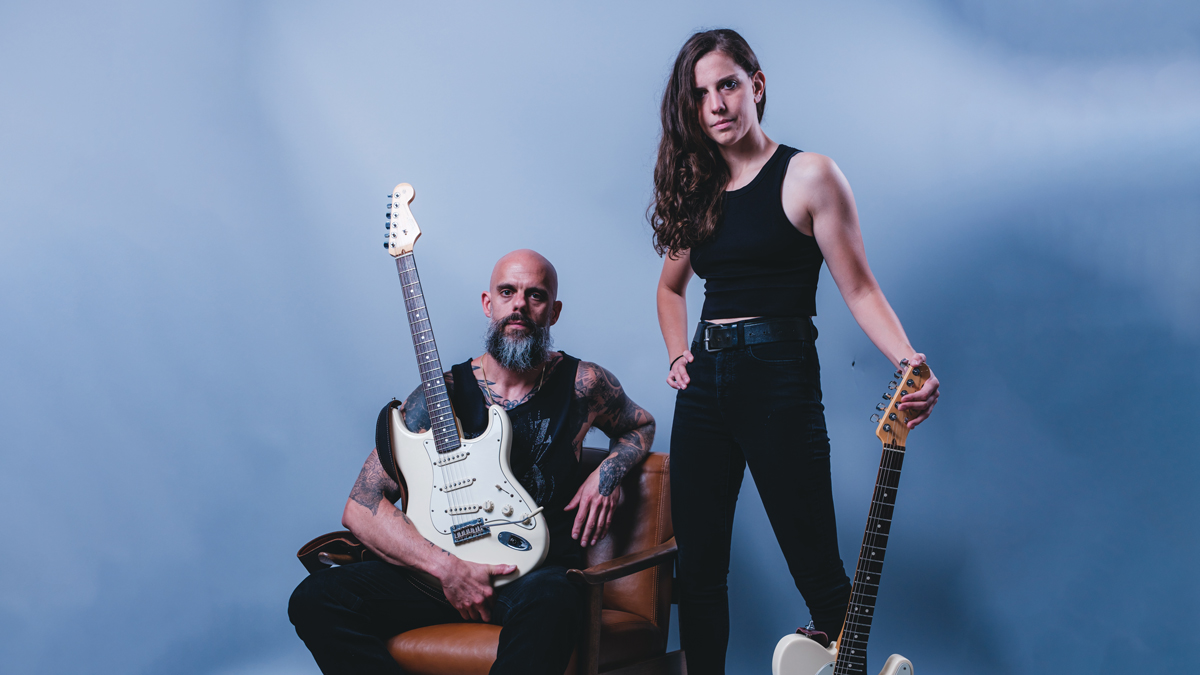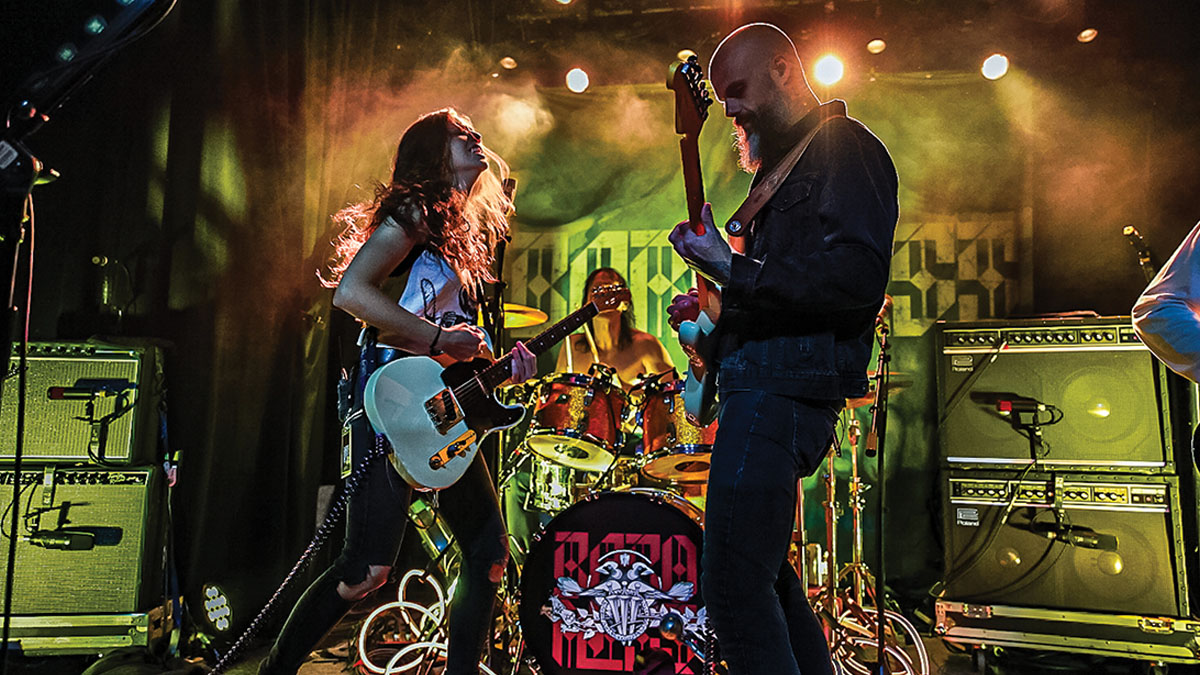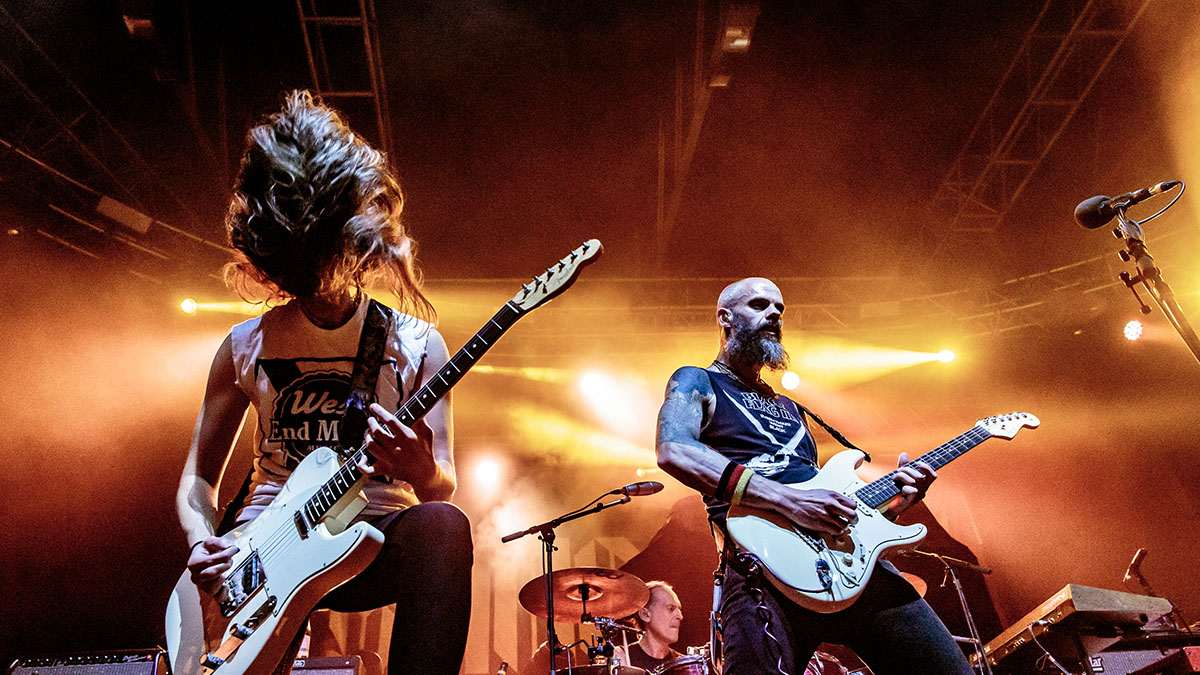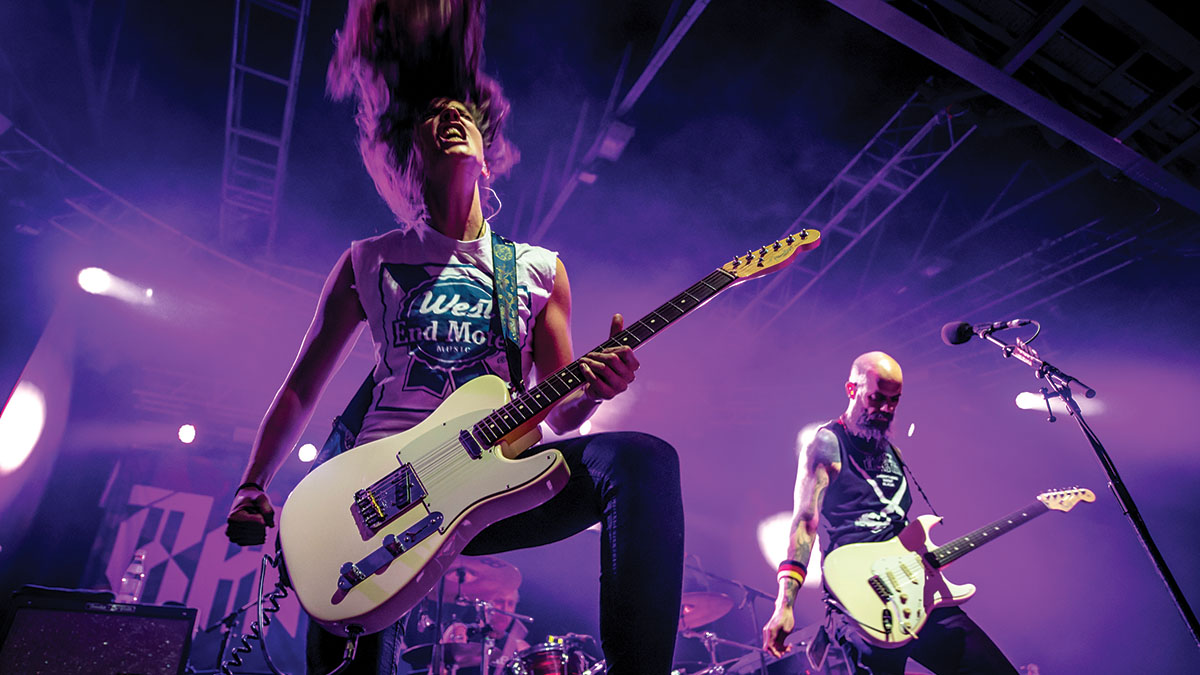
Alchemy. That’s how John Baizley describes it. The most inventive guitar duos always combine their strengths into a singular chemistry that creates something unpredictable and new. Think Angus and Malcolm Young. Kirk Hammett and James Hetfield. Slash and Izzy Stradlin.
On Stone, Baroness’ sixth and latest album of searing progressive metal, the pairing of guitarists John Baizley and Gina Gleason has arguably achieved similar heights, in its own way.
“This is one of the most fun and challenging records for me to ever put together, because that was the goal the whole time,” Baizley tells GW. “It was almost improvisational sometimes, to where Gina and I don’t really have to show each other what we’re doing; we just have to listen and feel it. Maybe we started as two guitar players acting in parallel, but we’re really trying to be one section of this band.”
Baizley and Gleason are sitting in Baizley’s Philadelphia home, where they spent countless hours woodshedding and refining the guitars on Stone before turning an Airbnb near the Canadian border into a makeshift studio, where they self-produced for the first time.
Stone also marks another first – a new beginning, really – as they’ve shed the thematic album titles that began with Red in 2017 and ended with Gold & Grey, Gleason’s first with the band, in 2019. Throughout the process of creating Stone, those efforts paid dividends over and over.
“Our chemistry presents itself in many different, cool ways on this record,” Gleason says. “There’s the really direct ways; like, on Beneath the Rose, there’s guitar harmonies and complementing riffs throughout the whole song. But then there’s Choir, which is a more abstract, loose composition where we’re doing really sparse guitar parts, [where] I’ll be playing a triplet phrase, but John will play the last note of it, and I’ll cut it off.”
Acoustic guitars – Baizley with his Rockbridge and Gleason on a Martin SC – turn up on nearly every song on Stone, beginning with the dreamy fingerstyle guitar on Ember. While that merely serves as an intro to Stone, quickly giving way to one of the album’s most brutal riffs on Last Word, acoustic guitars play a more prominent role on Magnolia and elsewhere provide texture behind their vintage amp tones.
“Once we’ve learned some standard practice, like fingerstyle guitar, it’s not hard for us to then apply that to electric guitar and find some new way of doing that,” says Baizley, who fell in love with the technique after discovering John Fahey while on tour in England in 2006. (Gleason subsequently picked it up from Baroness albums.)
“That’s how life bleeds into art, bleeds back into life, bleeds back into art,” he says. “You constantly have to be cross-pollinating.”
Guitar World spoke with Baizley and Gleason about how their guitar partnership has solidified and led to the riffs, harmonies and interplay on Stone.
Coming off your previous color-themed albums, was Stone mapped in advance?
Baizley: “No, this one had no roadmap whatsoever. With all of our records, in my mind, there’s only ever one rule, and that’s to identify the primary characteristic of the former record, and just not do that. So, if Gold & Grey was this overload of embellishments and complete psychotic onslaught of layering, like sonic destruction, then Stone only had to just not be that.”
Gina joined just before Gold & Grey. Now that you’ve been through a whole album-tour cycle, how do you relate as guitar players?
Gleason: “Being the new person in a group of musicians presents a lot of challenges. I had my own perspective of what I thought Baroness songs should sound like. But the band was like, Whatever you think a Baroness song should sound like, we already did that, so that’s not what we’re gonna do this time around.
“I had to re-approach how I go about playing guitar and thinking about my instrument and then come back full circle to my natural sensibilities. I think going through that process of pushing myself helped us gel as guitar players. I have a really good sense of John’s guitar impulses, and I feel like I [know] how to best complement that.”

Baizley: “Since the beginning of this band, I’ve never recorded with the same lineup twice until this record. Having a new member join from record to record creates the situation where you have to work within the reality of those confines.
“Now that we’ve gotten all that out of the way, we were able to be just John, Gina, Nick and Sebastian as Baroness, and we got into being creative where Gina and I, maybe we started as two guitar players acting in parallel, but we’re really trying to be one section of this band. It’s been really nice for us to get to this point and put a record together that is able to lean into that solidarity and chemistry.”
The pure joy of this record was that we didn’t have too much figured out before these songs became songs
The guitar parts on this record are well orchestrated, like the harmonies on Anodyne and all the acoustic textures, which were surprising to hear.
Baizley: “I think there’s an acoustic on almost every song, except Choir and Last Word. The pure joy of this record was that we didn’t have too much figured out before these songs became songs. We had a loose idea of some arrangements and some compositions before we really got down to business. But it felt to me that we were able to act on impulse whenever the mood struck.
“If the impulse was to pull out an acoustic guitar and use it in a more traditional way, like in some of our folky numbers, or as a texture or rhythmic element the way we use it in some of the louder songs, we were always ready to respond to those impulses. There’s this innate trust that runs throughout the process of songwriting whereby if it sounds cool and crazy, we’ll just try it.”
Did jamming so much on acoustic guitars lead into that being showcased on the record?
Gleason: “We play a lot of acoustic together, and I play a lot of acoustic guitar at home. I go through phases of months where all I play is nylon-string acoustic. And we write a lot on acoustic guitar. We write a lot of vocal stuff with acoustic guitars in our hands. This is a kind of band where it’s not like you go to band practice and you go home and that’s the end of band practice. It’s this all-consuming thing where there’s no separation.”
Baizley: “If it’s something we do offstage, off camera, off record, if it’s something we do musically that we enjoy doing, that means it’s appropriate and obligatory to bring into the recordings. I know there are bands who’ve got a sound that’s defined and particular enough that there would potentially be a discussion like, ‘Okay, we love playing acoustic music, but we’re Slayer’ [Laughs], and this isn’t an acoustic band. However, for us, it quite simply is whatever’s nearby that you can make music with, now’s the time.”

How did fingerstyle and hybrid picking seep into the new record?
Gleason: “The Last Word solo is hybrid picked until the last little chunk of it. A lot of times I’m tucking my pick in my index finger and using my thumb, because I want a more rounded sound, and that interacts in a cooler way with the effects I’m using.
“The Last Word guitar solo is a good example of that – it’s just like fuzz compressed as much as possible. Doing some of those runs with just a thumb and middle and ring finger interacted in a cool way with the effect.”
Obviously Randy Rhoads is monumentally amazing, but he’s one of those rare guitar players who’s technically fast but musical. He’s a storyteller, a complete player
It builds like a Randy Rhoads solo. Maybe it’s the legato playing – but it has a feel similar to Crazy Train. Was he much of an influence?
Baizley: “Yeah, it’s got the spirit of that, for sure. Obviously Randy Rhoads is monumentally amazing, but he’s one of those rare guitar players who’s technically fast but musical. He’s a storyteller, a complete player. And I think that’s what Gina did with that solo. There’s almost like a lyricism to it, a conversation.”
Gleason: “This was something we discovered, I think, on Gold & Grey, where we do these extended parts of songs, like take a motif from a song and expand on it in a way that has a lot of space, and maybe it’s the melody to a part of a song, but it’s spread out over longer intervals. So it naturally bled into the process of doing this record, and also our live show a lot.”
What guitars do you feel helped you dial in your tones?
Baizley: “It’s, like, 90 percent Stratocaster. The Strat, for me, is the tool that has the most variety and is easiest to play. There’s a little bit of Rickenbacker. There’s quite a bit of this ’62 ES-330 I’ve got, which I think at this point is my favorite guitar to play, but it’s so old and it’s so nice, it can’t leave the studio at all.
“I brought out my original Les Paul, which is I think an ’86; it’s one of those ones with three gold pickups. It’s ridiculous. It’s like Peter Frampton. [Laughs]”
What’s your pickup configuration on the Strat you’re using now?
Baizley: “It’s the standard triple-single, and I really love the two and four positions. I find myself spending a lot of time in those odd, between-pickup situations. It restricts the frequency output – at least it feels to me it does.
“We’ve certainly got a particular sound, but I think because of that and because of the nature of the way that Gina and I play and arrange our two guitars, I don’t treat them as equals. There’s like a tenor and an alto, like they’re supposed to occupy upper and lower sections rather than be twins.”
Gina, you’ve talked in the past about how you prefer Telecasters for their ability to cut through really well.
Gleason: “I have a 1992 G&L LSAT Classic that’s set up for our lower-tuned stuff. In 2017 at the Wiltern in Los Angeles, John was like, ‘Do you want to try this American Pro Tele?’ And I accidentally never gave it back. [Laughs]
“Usually [a Tele is] complemented with a Les Paul, but I think because of the pickup selections John favors, this has the same effect, like those more rounded-over Strat tones.”
Part of it, at least for me, was feeling comfortable with the idea that not every power chord I hit needs to be the heaviest, fullest, broadest thing of all time
John Baizley
You had a variety of vintage tube amplifiers in the mix. That’s uncommon for a quote-unquote metal band.
Baizley: “We fell in love with this old Gibson Falcon. It’s one of those really old ones that look more like furniture or something.”
Gleason: “I used to work at Guitar Center, and my friend, an old co-worker, was moving out of the country and was like, ‘Can you hold this amp for me?’ And that Falcon became a staple.”
Baizley: “For the end of Magnolia, we mic’d the back of a Fender Champ. We wanted to get the most vulnerable, emotionally intense sound, and it wasn’t gonna come from the smoothness or headroom of a nicer amp. It’s just this tiny amp being pushed to its absolute limit, and then capturing the sound from the back. It really sounds like something is about to become destroyed.”

“With this record, we hit on the idea that sometimes the instrument or the amp takes you where it needs you to go. I realize some of this older equipment doesn’t have the comprehensive range that more modern equipment has, but it’s actually much easier to use to tell a story or create a narrative, or in practical terms, stick out of a mix.
“Part of it, at least for me, was feeling comfortable with the idea that not every power chord I hit needs to be the heaviest, fullest, broadest thing of all time – that sometimes, something with a finer edge on it is actually more unique and captures your attention and your imagination, and thereby becomes a better creative tool because of its limitations.”
- Stone is out now via Abraxan Hymns.







